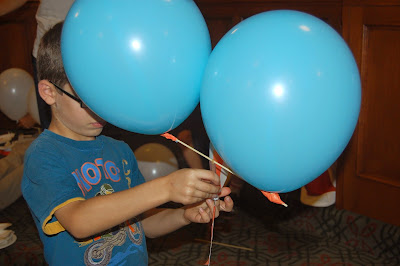Propeller Powered Balloon Helicopters

For today's Curiosity Machine classes, our last meeting of the four-week session, we did an exciting project from the Curiosity Machine website: balloon helicopters ! We learned about different kinds of energy, particularly elastic potential energy. Elastic potential energy is the potential energy stored when you bend, stretch or deform an object, and that energy converts to kinetic energy as the object bounces back. Here's a great website that explains it pretty well: Physics 20 Project . We discussed examples of elastic potential energy using a Family Feud presentation I made on Scratch. You can click on the image below to see the project, though it's supposed to be used as a tool for discussion: The project itself was challenging and I'm glad I worked on my sample ahead of time. But it's so exciting to see those balloons fly! First, you have to cut a boba straw to about the same length as the rubber band you plan to use (when it's at equilibriu...

